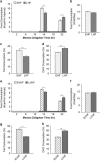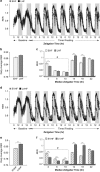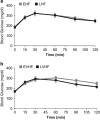The acute effects of time-of-day-dependent high fat feeding on whole body metabolic flexibility in mice
- PMID: 27133618
- PMCID: PMC5022109
- DOI: 10.1038/ijo.2016.80
The acute effects of time-of-day-dependent high fat feeding on whole body metabolic flexibility in mice
Abstract
Background: Both circadian disruption and timing of feeding have important roles in the development of metabolic disease. Despite growing acceptance that the timing of food consumption has long-term impact on metabolic homeostasis, little is known regarding the immediate influence on whole body metabolism, or the mechanisms involved. We aimed to examine the acute effects of time-of-day-dependent high fat feeding on whole body substrate metabolism and metabolic plasticity, and to determine the potential contribution of the adipocyte circadian clock.
Methods: Mice were fed a regimen of 4-h meal at the beginning and end of the dark (waking) cycle, separated by 4 h of fasting. Daily experimental conditions consisted of either an early very high fat or high fat (EVHF or EHF, 60 or 45% kcals from fat, respectively) or late (LVHF or LHF) meal, paired with a low fat (LF, 10% kcals from fat) meal. Metabolic parameters, glucose tolerance, body fat composition and weight were assessed. To determine the role of the adipocyte circadian clock, an aP2-CLOCK mutant (ACM) mouse model was used.
Results: Mice in the EVHF or EHF groups showed a 13.2 or 8.84 higher percentage of caloric intake from fat and had a 0.013 or 0.026 lower daily average respiratory exchange ratio, respectively, compared with mice eating the opposite feeding regime. Changes in glucose tolerance, body fat composition and weight were not significant at the end of the 9-day restricted feeding period. ACM mice did not exhibit different metabolic responses to the feeding regimes compared with wild-type littermates. Circadian clock disruption did not influence the short-term response to timed feeding.
Conclusions: Both the total fat composition of diet and the timing of fat intake may differentially mediate the effect of timed feeding on substrate metabolism, but may not induce acute changes in metabolic flexibility.
Figures






References
-
- Gimble JM, Sutton GM, Ptitsyn AA, Floyd ZE, Bunnell BA. Circadian rhythms in adipose tissue: an update. Curr Opin Clin Nutr Metab Care 2011; 14: 554–561. - PubMed
-
- Sherman H, Genzer Y, Cohen R, Chapnik N, Madar Z, Froy O. Timed high-fat diet resets circadian metabolism and prevents obesity. FASEB J 2012; 26: 3493–3502. - PubMed
MeSH terms
Substances
Grants and funding
LinkOut - more resources
Full Text Sources
Other Literature Sources
Research Materials

